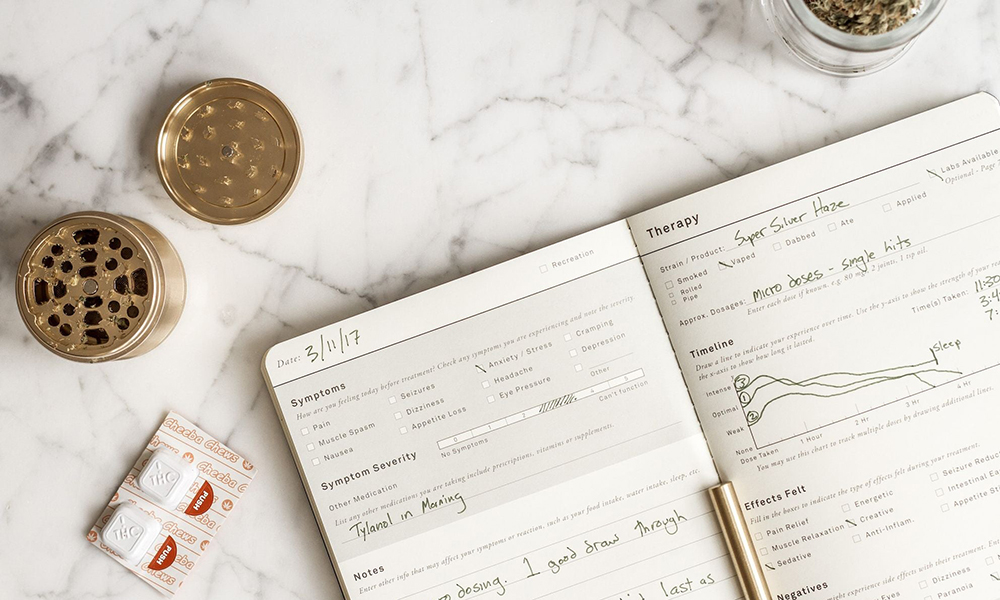What is a patient journal?
A cannabis patient journal is an easy tool that you can use to really hone in on your body, your medications, your supplements, and your overall health and wellness. There are several journals available specifically for cannabis patients, but, in reality, you don’t have to go out and spend a lot of money on one. A simple spiral notebook from your local store will suffice. We’re not going for fancy, or going for function.
Why do you need a patient journal?
Again, adding cannabis to your health and wellness regimen will take some adjustments. Your journal will allow you to keep track of your cannabis journey day by day and it enables you to then take a look back and review your progress daily, weekly, and monthly. You can see what worked, what didn’t work, and then tweak your cannabis consumption to find what makes you feel best.
Setting up your journal
What type of information should you be putting in your Journal? This is completely up to you and you can customize it for what works best for your own situation. It can be as simple or as elaborate as you like. Remember, you’ll be using it every day, so you want it to have as much information as possible for you and/or your doctor to review but you don’t want to write a novel either.
Medications and Supplements: List out all of your current medications, doses, and times you are taking them. Because this information usually stays pretty constant, you may want to list this out weekly or monthly instead of daily. Cannabis, however, should be listed out daily, as it may change from day to day.
Daily Vitals: Information such as your weight, blood sugar level, blood pressure, pulse, or oxygen level can be included in this section.
Symptoms and Severity: Write down your current symptoms and how bad the pain is (I use a scale of 1 to 10.) For instance you may list muscle pain (8), headache (6), and nausea (3). If your symptoms or pain levels change throughout the day, write it down too.
Cannabis Information
Cannabis products: List which products (brand, type, etc.) you are using, when you are taking them, and how much you are consuming.
Pain timeline: Make a small grid with times of the day in the severity of your symptoms. Plot it out hourly to see when your pay levels are higher or lower.
Effects felt and when: After taking your cannabis, note any changes, both physical and mental, and when they occur. Remember, sometimes it’s the absence of symptoms that you’re looking for as well. Some of your effects may include pain relief, muscle relaxation, fewer tremors, sedation, energy, creativity, seizure reduction, intestinal ease, appetite, focus, less anxiety, better mood, etc.
Negative effects: Although uncommon there are a few possible side effects of cannabis you should always write them down. These may include dry mouth, dry/red eyes, dizziness, nausea, drowsiness, couch lock, anxiety, rapid heartbeat, paranoia, headache, etc.
Daily outcome: When you are getting ready for bed, make one more entry for how the overall day went. Have your symptoms improved? Are they worse? Did they stay the same?
Notes: List anything that may not be covered above but is still important to write down.
Review and repeat
After you have your first week of entries, go back and review them. Has anything changed? Did you notice your pain levels go down at certain times of the day and with certain products? Did you find that you need more cannabis if you are going out to lunch with friends as opposed to when you were doing light work around the house? Did you find that you really don’t care for the effects of a sativa strain but felt immediate relief with indica? These questions and many more can be answered through being disciplined and jotting everything down in one place.
Share your information
Lastly, feel free to share this information with your spouse, partner, family, and especially your doctor. If he knows exactly how you are feeling in what symptoms are getting some relief, he will be better to help with your treatment. Again, you and your doctor are a team and your daily/weekly/monthly entries can help shed light on finding the right cannabis regimen for you.
One more thing
I know keeping a journal may sound like hard work, but this is your health. Taking five to 10 minutes a day to log everything in and reviewing it regularly could lead you to finding the relief that you want and need.





